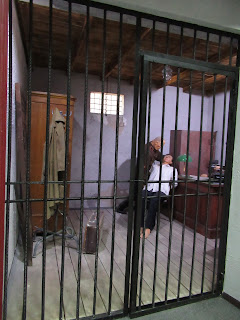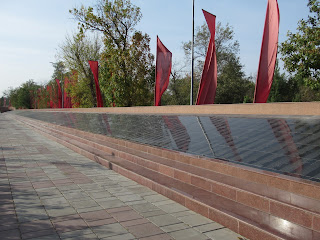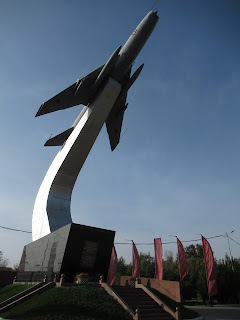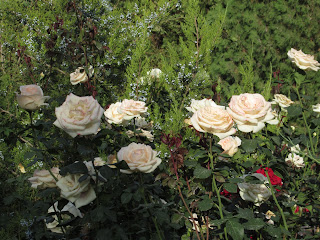We could hardly believe it when we checked into the same hotel in the Uzbekistan capital of Tashkent the day before and again saw Waldheim and Anna, the German couple we'd first met in Nukus located in the far northwestern part of the country! The four of us had shared a taxi so we could visit the Mizdakhan Necropolis, by far our favorite site in Nukus. We had also seen them in Bukhara, another city on the Silk Road trail about ten days earlier - what a small world, we thought. Unfortunately, our paths wouldn't cross again as we were heading on to Shymkent, a city in southern Kazakhstan.
After walking for more than a quarter mile, we finally made it to Uzbek Immigration where a kind border patrol agent took one look at us standing in a long line, realized we were foreigners and took our passports and told everyone to make way so we could get to the front of the line. We felt badly for all the other people but none of them seemed to mind nor were surprised that we foreigners were getting preferential treatment. You may recall from an earlier post that Uzbekistan is still a police state so it wouldn't 'do' for them to complain, I figured.
We'd been warned the land crossing may well take up to three hours but we got through in about 90 minutes after being dropped off by the taxi so we were happy. As soon as we got over to Zhibek Zholy on the Kazakh side of the border, we arranged with a driver to take us to Shymkent, about a 100 klicks away. But, once he walked us to his taxi, he then said he needed to go back and get two more people or the price we'd agreed on would be double, i.e. we'd have to pay for the entire car! After waiting for 30 minutes with no sign of the driver and other passengers returning, we got another driver to take us all the way and for only $30 for the 90 minute ride. I left a small amount of money in the first car as a way of saying "Sorry, we didn't want to wait any longer" and hoped he would understand.
The center of the museum's display was a portrait gallery of Kazakh politicians and other public figures who were victims of political repression.
It was heartening seeing the signs of life in the form of such beautiful roses growing the entire length of the memorial.
Another cute sign for you know what!
Anvar, our hotel owner who had spent many years in the States, generously showered us with gifts before arranging a taxi to take us to the Uzbek border with Kazakhstan, about 25 miles away, for only 40,000 som or $5. Traffic was so bad at a major intersection leaving the capital the driver ended up going in the opposing traffic lane. In almost no time, there were three lanes of cars all driving in the opposing lanes which reduced the oncoming traffic lanes to just one. I wished I hadn't sat in the front and witnessed the crazy driving!
Once the driver let us off, we had quite a schlep through no man's land with our bags, including the extra souvenir bag we'd picked up the day before in the fascinating Urgut Bazaar outside of Samarkand.
Another sign for my bathroom sign collection!
After walking for more than a quarter mile, we finally made it to Uzbek Immigration where a kind border patrol agent took one look at us standing in a long line, realized we were foreigners and took our passports and told everyone to make way so we could get to the front of the line. We felt badly for all the other people but none of them seemed to mind nor were surprised that we foreigners were getting preferential treatment. You may recall from an earlier post that Uzbekistan is still a police state so it wouldn't 'do' for them to complain, I figured.
How great it was to be back on regular paved roads and even a divided highway again after driving on Uzbekistan's generally lousy roads for the last several weeks. It's amazing the things that make life easier when you travel or, to put it another way, the things you miss or take for granted.
In case you were wondering Kazakhstan, a former Soviet Republic, is a vast and rarely explored expanse, south of Russia and to the west of China. It's the size of Western Europe, but with scarcely a person in sight!
The driver needed gas on the way but, unlike what happened in Uzbekistan, we didn't need to get out of the taxi this time! The driver stopped to fill up with propane at a mini station very close to the regular gas station. Many vehicles in Central Asia used propane and not gas, we noticed by the propane tanks in the trunk or on the tops of buses, etc.
About a month earlier, we'd spent most of a day in the Kazakh city of Almaty but we wanted to explore two other cities, Shymkent and Turkestan, in the southern part of the country before returning to Almaty for a couple of more days in about a week. The Mongols raised a minor Silk Road stop in what later became Shymkent. The Kokand khanate, or political entity run by a khan, built a frontier fort in the 19th century, Russia took it in 1864 and the whole city was rebuilt when it was under Soviet domination. Now, Shymkent is a thriving trade center and also produces cement, phosphates, refines oil and brews two of Kazakhstan's best beers!
Once we dumped our bags in the small apartment we'd rented for two nights, we walked a couple of blocks to Abay Park.
We headed directly to the Museum to the Victims of Political Repression. Never had we seen any museum with such a small entrance!
This was the first time visiting any museum in Central Asia we'd received a pamphlet about a museum. Things were looking up definitely! The museum's focus was on the victims of political repression during the Soviet era and how they were rehabilitated after Kazakhstan became an independent state in December of 1991. The museum was opened just ten years later.
Unfortunately, none of their stories were in English.
In the middle of the portrait gallery was a moving sculpture called Repression which showed figures striving for freedom restrained by a Soviet banner. At its base was dripping red paint signifying the blood that was shed.
It was only through reading the brochure we understood about the famine that caused the death of more than three million Kazakh people, the rebellion of the poor farmers in a town called Sozak, the emigration of more than one million Kazakhs to China, Afghanistan and Iran in order to save their and their children's lives, the reprisals against 25,000 Kazakhs during the period of mass terror and the riots that occurred in 1986 when young people sought independence for their homeland.
I read that 'rehabilitation certificates' were granted but I don't know what that entailed.
On the upper level was the Memorial Hall with display boards showing the names of 2,500 people executed in the 1930s in southern Kazakhstan
It is always easy to think about the tragedy of war and the victims of repression in the abstract but seeing and actually being able to touch their names brought it home.
The staff seemed extremely pleased that foreigners would take an interest in this aspect of their history. It was gripping to learn the events during the Stalinist era were all the more tragic for the Kazakhs as they also destroyed their traditional way of life.
A view of the small museum from the memorial space:
Right across the street in Abay Park was a WW II memorial.
Just beyond the memorial was Alleya Slavy or Alley of Glory that contained plaques that bore the names of the more than 140,000 people only from southern Kazakhstan, i.e. where Shymkent is located, that lost their lives in the Second World War.
It was heartening seeing the signs of life in the form of such beautiful roses growing the entire length of the memorial.
Halfway down the Alley of Glory was another memorial. Steven and I hazarded a guess it may have been to the generals who led their troops because of the prominence given certain names on the memorial.
Those soldiers from southern Kazakhstan who had died were listed by city - these were the ones whose home had been Shymkent.
Again, beauty amid such sorrow:
At the end of the memorial was a military fighter jet that was dedicated to the Soviet pilots who sacrificed their lives during World War II. The monument was built about thirty years ago and moved to Abay Park from the central city square.
Walking through the park was so peaceful and relaxing after what had been a pretty hectic time gazing at the fantastic Timurid religious architecture, day in and day out, in Uzbekistan. It wasn't until now as I write this post that I barely recall any parks in the five cities we spent time in in that country, except for a few in Tashkent, the capital. Uzbekistan has so much going for it but public parks is not its forte.
I smiled as I walked all the way around this fountain trying to see it but it was almost one hundred percent blocked by foliage!
I joked with Steven the city administrators should call it 'Shymkent, the City of Roses" as the flowers were so common!
Even though we hadn't done that much that day we were still tired by the time we found a place to eat dinner. What seemed to be the most convenient choice was a cafeteria just minutes from the park and our apartment. Steven chose goulash and a side of roast potatoes and I selected a meat cutlet of some sort with mashed potatoes. All that plus tea only came to 1,320 tengue, about $4!
Next post: Exploring more of Shymkent.
Posted on November 9th, 2018, from Salamanca, Spain.





























































No comments:
Post a Comment